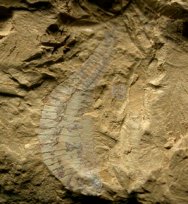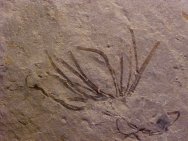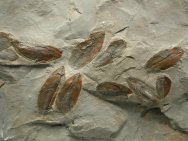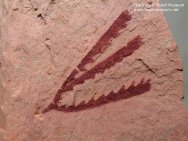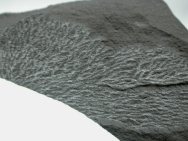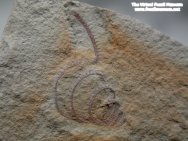Phylum Hemichordata & Graptolites
Phylum Hemichordata Fossils, including Graptolites |
From the first dawn of life, all organic beings are found to resemble each other in descending degrees, so they can be classed in groups under groups. Charles Darwin, Origin of Species, Chapter 13 | |||||||||||||||||||
Most people are unfamiliar with the animals within Phylum Hemichordata, which is small and contains but a few hundred species. They turn out to be, nonetheless, very important in the study of the evolutionary origins of vertebrates. The name Hemichordate, meaning half chordate, derives from their having only some characteristics of Chordates, while lacking others. They are deuterostomes characterized by embryonic development where the first opening (the blastopore) becomes the anus, in contrast to protostomes where it becomes the mouth. As deuterostomes, the hemichordates are a sister group to both the true Chordates and the Echinoderms. The most distinguishing characteristic of the Hemichordates is a more primitive form of notochord, called a stomochord that contained a nerve system. This tube provides the basis for placing the Hemichordates as a sister group to true Chordates. They also have branchial openings, or gill slits, that open into the pharynx. There are three classes of Hemichordates. The Enteropneusta are the acorn worms that remain extant. The Pterobranchia are also extant and form a small and obscure group that form colonies in which the individuals are interconnected by stems, or stolons made from collagen protein. Members of Class Graptolithina (the Graptolites) are common fossils with a worldwide distribution making them important as index fossils, particularly for dating Palaeozoic sediments. Graptolite fossils were once colony of tiny animals that either floated in the sea or was attached to the sea floor like a crinoid. The graptolite colony consisted of one or many branches that were straight, curved or spiral. The individual animals lived within structures along the length of a community exoskeleton formed from collagen. Graptolite fossils appear from the Cambrian and dissapear in the Carboniferous. Yannanozoon lividum from the early Cambrian Chengjiang Biota is a putative, primitive hemichordate, though some scientists have assigned it to the enigmatic phylum Vetulicolia. The most prevalent Hemichordate fossils are the Graptolites which were colonial animals that are primarily known from the upper Cambrian through the Lower Carboniferous (Mississippian) of the Paleozoic. A graptolite colony is called a rhabdosome and will have a varying number of branches called stipes that come from the initial animal individual called a sicula. Each subsequent individual (zooid) was housed within a tubular or cup-like structure (called a theca).
|
||||||||||||||||||||
Fossil
Museum Navigation:
Home Geological Time Paleobiology Geological History Tree of Life Fossil Sites Fossils Evolution Fossil Record Museum Fossils |

